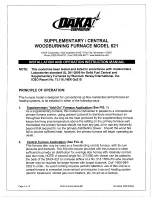
Well sealed flue system
Only materials and items approved for solid fuel stoves should be used for your stove as fuel.
Under no circumstances should you use aluminium or galvanised steel pipes for your stove flue.
Always fit pipes with the narrow side down, this allow any creosote to run down the inside of the
pipe and not to come out and cause an unsightly mess and possible fire hazard. All joints in the
flue system should be sealed with fire cement and/or an appropriate fire resistant rope or gasket.
Pipe bends should be kept to a minimum and we do not recommend using more than 2 bends on
any installation. Likewise the length of horizontal sections of the flue system should be kept to a
minimum. Always follow flue manufacturers' instructions when installing fabricated flues. Flues
must not pass through ceilings, floors, attics, roofs, or combustible walls without adequate and
approved insulation being provided to protect combustible materials.
The chimney and flue provide a means of taking combusted fuel from the stove, as well as a
draught to enable the stove to work. It is essential that the flue system is kept in good condition
and there are no breaks or cracks allowing contact with any other combustible materials of the
House. It is also essential that the flue system is kept clean and seals are maintained to ensure the
Draught is not lost. If the flue system is broken or cracked it should be lined with an approved lining
system.
The open end of the flue system must be above the height of the apex of the building and any
other obstructions, such as trees, which are within 3 meters (10ft) of the flue system. Failure to do
this will affect the efficiency of the stove and may cause down draughts which will mean dangerous
Products of combustion are emitted into room.
Under no circumstances should the flue pipe be less than 5
(125mm) internal diameter.
The
stove should not be connected to a chimney which is used on any other appliance or which
connects to other rooms in the building.
it has been lit but as the temperature in the firebox rises the smoke should become lighter and the
glass should clear. If this is not happening then you may need to provide an outside air supply into
the room. As a simple check for this open a door or window in the room and check if the stove
burns more efficiently.
Plumbing [Wetback (Boiler) Model Only]
We recommend that the stove be connected to the heating system by a qualified craftsman. All
plumbing must comply with relevant national standards.
The pipe fittings on your boiler model stove are 1
BSP, all inlet and outlet piping and connections
should be 1
BSP or larger. An indirect water heating cylinder should be installed such that there
is not more that 7.6m of piping between the stove and the cylinder.
An expansion pipe must be fitted to the stove water outlet pipe which must be vented to atmosphere
above the height of the header tank. There must be no valves between the stove and this vent pipe
outlet and it must not be possible to obstruct the outlet in anyway.
Protection of combustible materials
The following clearances should be maintained from all combustible materials,
Back of stove - 760mm
Sides of stove - 510mm
It is important to note not all combustible materials can be seen (such as wooden studs in walls)
and care should be taken to ensure you have thoroughly checked all materials in the vicinity of the
stove. You should also note that Fire Resistant materials will burn and should be treated like other
combustible materials.
The stove itself should be placed on a non-combustible surface of minimum 10mm thickness and
this should extend 460mm in front of the stove, 200mm at the sides and back of the stove. This
floor protection should also be placed under any horizontal length of the flue system protruding out
of the back outlet and should extend 50mm either side of the pipe.
1. Remove your stove from the outer packaging and place on the floor. Inspect stove, check for
any damage, if damage is found or suspected, please contact your dealer. Never attempt to use a
stove that has been damaged.
2. Please follow the instructions below if you are installing the stove yourself, however if
5
6
Unpacking and preparing your stove for installation


























